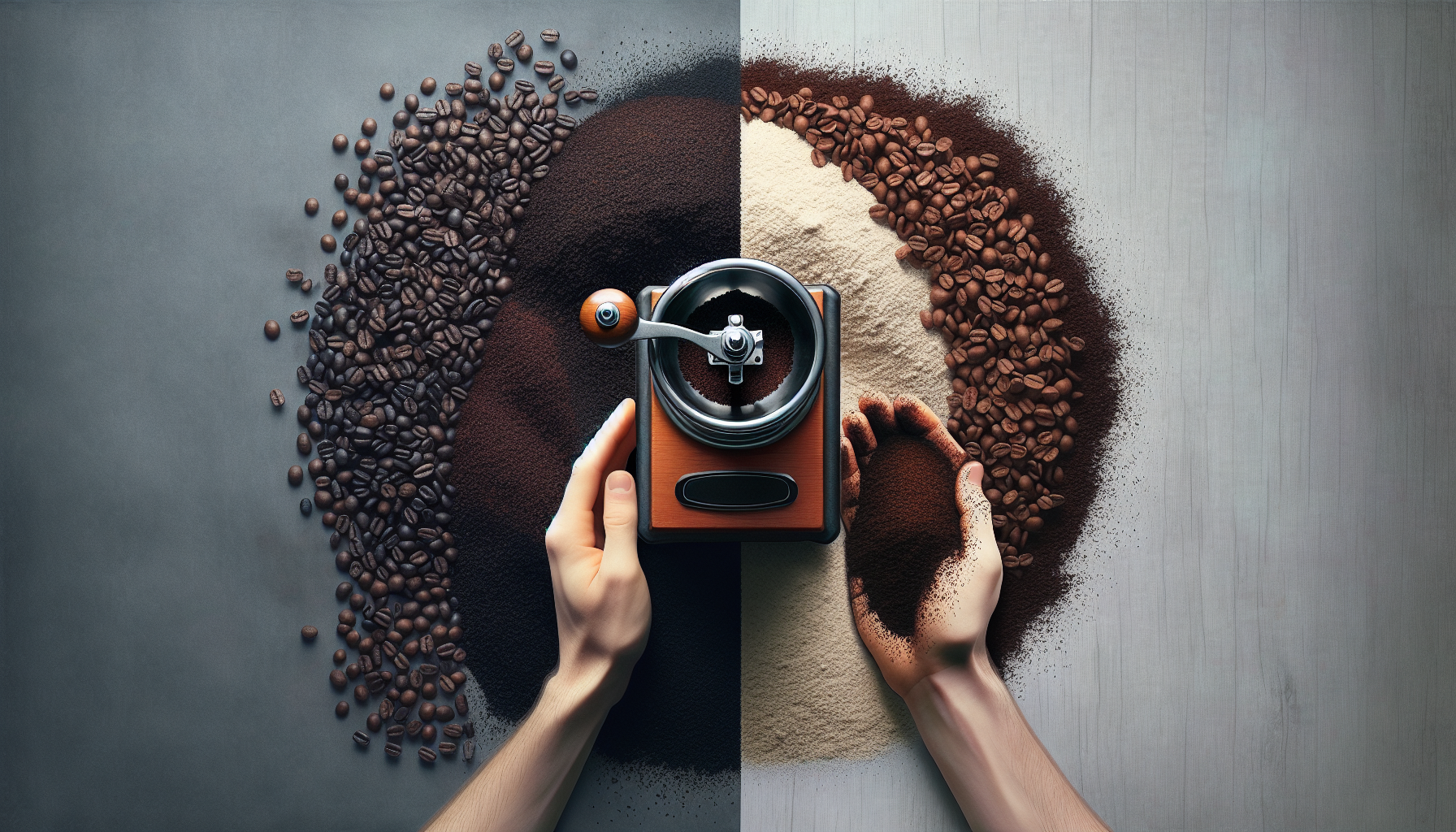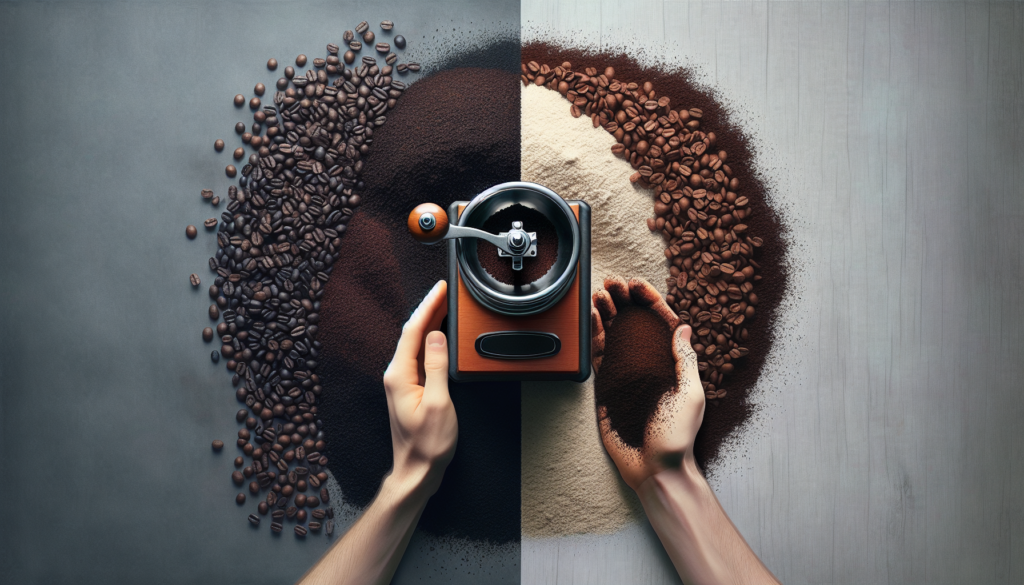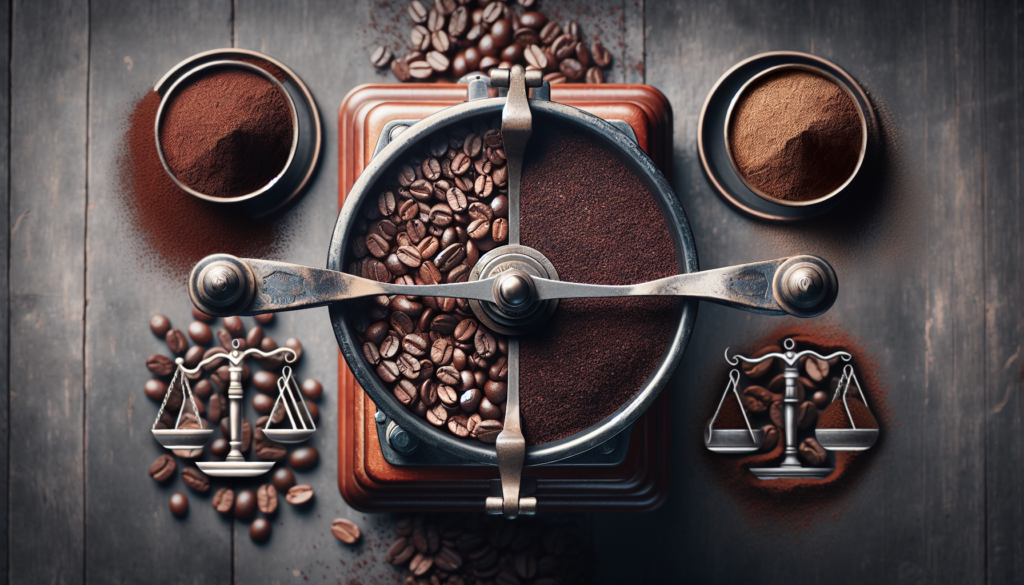
Are you a coffee enthusiast looking to elevate your brewing experience? If so, you may be interested in delving into the fascinating world of coffee grinding and its impact on flavor. In this article, we will explore the intricate connection between coffee grind size and the resulting taste in your cup. By understanding how the grind affects the extraction process, you will be able to fine-tune your brewing methods and unlock a whole new level of complexity and satisfaction in every sip. So grab your favorite mug and prepare to embark on a journey of coffee discovery!

The Role of Coffee Grinding in Taste
Coffee grinding plays a vital role in the overall taste and flavor of your favorite cup of coffee. It is often overlooked, but the way the coffee beans are ground can greatly affect your brewing process and the resulting flavors in your cup. Understanding the relationship between coffee grinding and taste is essential for coffee enthusiasts who want to elevate their brewing and enjoy a truly exceptional cup of coffee. Let’s explore how grinding affects the extraction process, the impact of grind size on flavor, and the importance of finding the right grind for your palate.
Grinding as an Essential Step in Coffee Brewing
grinding coffee beans is a crucial step in the coffee brewing process. A whole coffee bean has limited surface area for water to penetrate and extract flavor. By grinding the beans into smaller particles, we increase the surface area, allowing for better extraction. This step breaks down the beans into smaller fragments, making it easier for hot water to dissolve the flavors locked inside the coffee grounds. Without proper grinding, the extraction process would be incomplete, resulting in a weak and underwhelming cup of coffee.
How Grinding Affects the Extraction Process
The extraction process is the transfer of soluble compounds from the coffee grounds to the water, creating the flavors we love in our cup of joe. The size of the coffee grounds has a significant impact on the extraction process. When the coffee is ground too finely, the water tends to pass through the grounds slowly, leading to over-extraction and a bitter taste. On the other hand, if the coffee is ground too coarsely, the water passes through too quickly, resulting in under-extraction and a weak, watery flavor. Achieving the right grind size is crucial to ensure optimal extraction and a well-balanced cup of coffee.
The Impact of Grind Size on Flavor
Grind size plays a crucial role in determining the flavor profile of your coffee. Different brewing methods require specific grind sizes to achieve the desired flavors. For example, a fine grind is typically used for espresso, as it allows for a slow extraction and produces a concentrated, bold flavor. In contrast, a coarse grind is best suited for French press brewing, as it allows for a longer extraction time, resulting in a full-bodied and rich cup of coffee. The size of the coffee grounds directly affects the rate at which flavors are extracted, intensifying or mellowing the overall taste.
Understanding the Relationship Between Grind and Palate
Your personal preference and taste buds also come into play when determining the ideal grind size for your coffee. Each individual has a unique palate and may prefer certain flavor profiles over others. Some coffee enthusiasts prefer a brighter and more acidic flavor, while others enjoy a smoother, more mellow taste. Experimenting with different grind sizes can help you find the perfect balance to suit your palate. It is important to consider both the brewing method and your personal taste preferences when adjusting the grind size to achieve a coffee that truly satisfies your cravings.

Grinding Methods
There are several methods of grinding coffee beans, each with its own pros and cons. Let’s take a closer look at the most common grinding methods: burr grinders, blade grinders, and manual grinders.
Burr Grinders
Burr grinders are widely regarded as the best option for achieving a consistent grind size. These grinders use two abrasive surfaces, known as burrs, to crush and grind the coffee beans. The distance between the burrs can be adjusted to control the fineness of the grind. Burr grinders offer precise control, resulting in a uniform grind that enhances extraction and flavor.
Blade Grinders
Blade grinders, on the other hand, use a spinning blade to chop the coffee beans into smaller pieces. While blade grinders are often more affordable and readily available, they tend to produce an inconsistent grind size. The lack of control can lead to uneven extraction and a less flavorful cup of coffee. However, with proper technique and careful monitoring, it is still possible to achieve a decent grind with a blade grinder.
Manual Grinders
Manual grinders require some physical effort but offer excellent control over the grind size. These grinders typically use a hand crank to grind the coffee beans. Manual grinding allows for a more hands-on approach, allowing you to adjust the grind size to suit your specific brewing method. It may take more time and effort, but many coffee enthusiasts appreciate the level of control and connection to the coffee-making process that manual grinders provide.
Grind Size and Extractions
The grind size of your coffee beans directly affects the extraction process and, consequently, the flavor of your coffee. Different brewing methods require specific grind sizes to optimize extraction. Let’s delve into the three main categories of grind size: fine, medium, and coarse.
Fine Grind
A fine grind is characterized by a powdery texture, similar to table salt or powdered sugar. This grind size is commonly used for espresso machines, where the water is forced through the grounds under high pressure. The fine grind allows for a more extended extraction time and produces a concentrated, intense flavor. However, caution must be exercised when using a fine grind, as over-extraction can easily occur, resulting in a bitter and unpleasant taste.
Medium Grind
The medium grind falls somewhere between the fine and coarse grinds, resembling granulated sugar. It is the go-to grind size for traditional drip coffee makers and pour-over methods like the V60. The medium grind provides a balanced extraction, ensuring a well-rounded flavor. It is versatile enough for various brewing methods and offers a good starting point for experimenting with different flavors.
Coarse Grind
A coarse grind has a rough texture, similar to kosher salt or breadcrumbs. This grind size is primarily used for brewing methods with longer extraction times, such as french press or cold brew. The coarse grind allows for a slower extraction, resulting in a full-bodied and less acidic cup of coffee. It is worth noting that the coarse grind may require a longer brewing time to achieve optimal extraction and flavor.
Adjusting Grind Size for Different Brewing Methods
To achieve the best possible flavor from your chosen brewing method, it is crucial to adjust the grind size accordingly. Each brewing method requires a specific grind size to optimize extraction and achieve the desired flavors. Experimentation is key to finding the perfect balance for your taste preferences. If your coffee tastes bitter or over-extracted, try using a coarser grind. If it tastes weak or under-extracted, try using a finer grind. fine-tuning the grind size can significantly enhance the flavors in your cup of coffee.
Flavor Profiles Associated with Grind Size
The grind size directly influences the flavors that are extracted from the coffee grounds during the brewing process. Understanding the flavor profiles associated with different grind sizes can help you tailor your brewing technique and achieve the perfect cup of coffee.
Over-Extracted Coffee
When coffee grounds are over-extracted, it means that too much flavor has been drawn out, resulting in a bitter or harsh taste. This can occur when using a grind size that is too fine, as the water takes longer to pass through the grounds, allowing for excessive extraction. Over-extracted coffee may also exhibit a burnt or astringent flavor. If your coffee tastes bitter, like over-steeped tea, it is likely that the grind size is too fine, and the extraction time is too long.
Under-Extracted Coffee
Conversely, under-extracted coffee occurs when insufficient flavor has been extracted from the coffee grounds, resulting in a weak, sour, or acidic taste. This is commonly caused by using a grind size that is too coarse, allowing the water to pass through the grounds too quickly. Under-extracted coffee lacks the full flavor profile and can taste watery or lacking in body. Adjusting to a finer grind size or increasing the extraction time can help alleviate the under-extraction issues.
Balanced Extraction
The ultimate goal when brewing coffee is to achieve a balanced extraction. This means extracting just the right amount of flavor from the coffee grounds to produce a well-rounded and flavorful cup. Balanced extraction results in a coffee that is neither too bitter nor too sour, showcasing the nuances and complexities of the beans. Finding the right grind size to achieve this balance is key to unlocking the optimal flavors from your coffee beans.
Achieving Desired Flavors Through Grind Adjustment
Grind adjustment is a crucial element in achieving the desired flavors in your cup of coffee. By fine-tuning the grind size, you can customize your brewing process to suit your taste preferences. Experimentation and a willingness to explore different grind sizes are essential in this process.
Finding the Right Grind Size for Personal Preference
Finding the right grind size for your personal preference requires some trial and error. Start by experimenting with different grind sizes within the recommended range for your brewing method. Brew small batches using incremental adjustments to the grind size, then taste and evaluate the flavors. Take note of the grind size that produces the flavors you enjoy the most. This iterative process will help you determine the ideal grind size for your palate.
Experimenting with Different Grind Sizes
Don’t be afraid to experiment with grind sizes outside the recommended range for your brewing method. You may discover unique flavor profiles or preferences that suit your taste buds. Some coffee enthusiasts enjoy using a slightly finer grind for their pour-over coffee to enhance the acidity and brightness, while others prefer a coarser grind to accentuate the body and sweetness. Embracing experimentation allows you to further personalize your coffee brewing experience and uncover hidden flavors.
The Importance of Consistency
Consistency is key to achieving consistently great coffee. Once you find the grind size that produces the flavors you enjoy, it is vital to maintain that consistency in your brewing routine. Keeping a record of your preferred grind size and brewing parameters will help you recreate those delicious cups of coffee consistently. Consistency in grind size, water temperature, and brewing time all contribute to unlocking the full potential of your coffee beans.
Factors Affecting Grind Consistency
Achieving a consistent grind size can be influenced by several external factors. It is important to be aware of these factors and make adjustments if necessary to ensure a uniform grind.
Grinder Quality and Consistency
The quality and consistency of your coffee grinder play a significant role in achieving a consistent grind size. Burr grinders are generally more reliable in producing a uniform grind compared to blade grinders. Investing in a high-quality burr grinder can greatly enhance the consistency of your coffee grounds and, in turn, the quality of your brew.
Bean Roast Level
The roast level of the coffee beans can also impact the grind consistency. Darker roasts tend to be more brittle and can result in inconsistencies during grinding. Lighter roasts, on the other hand, are denser and may require a coarser grind size to achieve optimal extraction. Understanding the characteristics of the coffee beans you are using and adjusting your grind accordingly can help maintain consistency.
Humidity and Ambient Conditions
Humidity and ambient conditions can affect the texture of the coffee beans and subsequently impact the grind consistency. In humid environments, coffee beans tend to absorb moisture from the air, becoming softer and more prone to clumping. This can result in uneven grinding. To mitigate this, it is advisable to store your coffee beans in an airtight container in a cool and dry place.
Storage of Coffee Beans
The way you store your coffee beans can also affect the grind consistency. Proper storage helps preserve the freshness and integrity of the beans, ensuring a consistent grind. It is recommended to store your coffee beans in airtight containers away from exposure to light, heat, and moisture. Grind your beans just before brewing to retain maximum freshness and flavor.
Grinding Techniques for Optimal Flavor
In addition to choosing the right grind size and considering external factors, there are specific techniques that can further enhance the flavor of your coffee. Implementing these techniques can contribute to a more enjoyable brewing experience.
Grinding Just Before Brewing
Grinding your coffee beans just before brewing is a crucial step in ensuring optimal flavor. Ground coffee starts to lose its freshness and flavor as soon as it is exposed to air. By grinding your beans immediately before brewing, you preserve the aromatics and flavors locked within the beans, leading to a more flavorful cup of coffee.
Avoiding Overheating the Coffee
Heat can also affect the flavor profile of your coffee. When grinding, be mindful of the heat generated by the grinding process. Some high-speed blade grinders can generate heat that can potentially harm the delicate flavors of the coffee. If using a blade grinder, pause intermittently during the grinding process to prevent overheating. Burr grinders, being slower and less prone to heat generation, are a better option for preserving the flavors of the coffee.
Avoiding Contamination and Off-flavors
Contamination and off-flavors can negatively impact the taste of your coffee. When grinding coffee, ensure that your grinder is clean and free from any old coffee residue or oils that could taint the flavor of the freshly ground beans. It is also important to use clean equipment and water when brewing your coffee to prevent any off-flavors from affecting the final cup.
The Role of Brewing Method in Grind Selection
Different brewing methods require specific grind sizes to maximize flavor extraction. Understanding the recommended grind sizes for various brewing methods can help you choose the most suitable one for your preferred coffee style.
Espresso
Espresso brewing requires a fine grind size. The rapid extraction process of espresso machines necessitates a compact and highly pressurized bed of coffee grounds. A fine grind ensures that the water can effectively extract the desired flavors within the short contact time.
Pour-Over
Pour-over brewing methods, such as the V60, typically call for a medium grind size. The slow and controlled pour allows for a balanced extraction and highlights the nuances of the coffee. The medium grind ensures optimal flow rate and flavor extraction throughout the brewing process.
French Press
French press brewing uses a coarse grind size. The extended steeping time allows for a full-bodied and rich cup of coffee. The coarse grind ensures that the water can interact with the coffee grounds over an extended period, resulting in a more pronounced flavor profile.
Cold Brew
Cold brew requires a very coarse grind size. The extended brewing time and cold water extraction create a smooth and low-acidity coffee concentrate. The coarse grind allows for a slow extraction, producing a rich and mellow flavor without any excessive bitterness.
Professional Techniques for Coffee Grinding
Professional baristas employ advanced techniques to achieve the utmost precision in their coffee grinding. These techniques ensure consistency and help refine the extraction process for the best possible flavor.
Dialed-in Espresso Grinding
In the world of espresso, achieving the perfect grind size and consistency is crucial. Baristas engage in a process known as “dialing in” to find the optimum grind size for a particular coffee bean. This involves adjusting the grind size and other variables while continuously tasting and evaluating the resulting shots of espresso until the desired flavors are achieved.
Grind Distribution Analysis
Grind distribution analysis is a technique used by professionals to evaluate the particle size distribution of their coffee grounds. This analysis helps baristas understand the consistency of their grind size, allowing them to fine-tune extraction and flavor. By utilizing specialized tools like sieves or microscopy, they can identify any inconsistencies or irregularities, enabling them to make necessary adjustments for optimal extraction.
Particle Size Distribution and Extraction
Understanding particle size distribution is crucial in optimizing extraction and flavor. Advanced equipment, such as laser diffraction particle analyzers, allows professionals to measure the size distribution of coffee particles accurately. This information helps in tailoring the brewing parameters, such as water flow rate and extraction time, to achieve a more controlled and precise brewing process.
Conclusion
In conclusion, the role of coffee grinding in taste is undeniable. The proper grind size, chosen based on the brewing method and personal preference, can significantly impact the flavor and overall enjoyment of your coffee. Through experimentation, consistency, and an understanding of the factors affecting grind consistency, you can unlock the full potential of your beans and create a cup of coffee tailored to your palate. Embrace the connection between grind and palate, and elevate your coffee brewing experience to new heights.